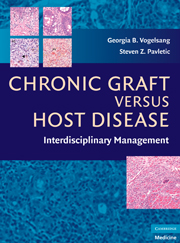Book contents
- Frontmatter
- Contents
- List of Contributors
- Preface
- PART I GENERAL PRINCIPLES
- PART II CLINICAL MANAGEMENT
- PART III ORGAN SITE OR SYSTEM-SPECIFIC MANIFESTATIONS
- 16 Cutaneous Manifestations of Chronic Graft versus Host Disease
- 17 Oral Chronic Graft versus Host Disease
- 18 Chronic Ocular Graft versus Host Disease
- 19 Gynecological Manifestations of Chronic Graft versus Host Disease
- 20 Gastrointestinal and Hepatic Manifestations of Chronic Graft versus Host Disease
- 21 Chronic Graft versus Host Disease and the Lung
- 22 Hematologic Complications of Chronic Graft versus Host Disease
- 23 Neurological Manifestations of Chronic Graft versus Host Disease
- 24 Rehabilitation Evaluation and Treatment of Patients with Chronic Graft versus Host Disease
- 25 Infections
- 26 Endocrine and Metabolic Effects of Chronic Graft versus Host Disease
- 27 Other Manifestations of Chronic Graft versus Host Disease
- 28 Psychosocial Issues in Chronic Graft versus Host Disease
- 29 Secondary Malignancies and Other Late Effects
- 30 Health-Related Quality of Life (HRQOL) in Chronic Graft versus Host Disease
- PART IV SPECIAL CONSIDERATIONS IN CHRONIC GVHD
- Index
- Plate section
21 - Chronic Graft versus Host Disease and the Lung
from PART III - ORGAN SITE OR SYSTEM-SPECIFIC MANIFESTATIONS
Published online by Cambridge University Press: 26 August 2009
- Frontmatter
- Contents
- List of Contributors
- Preface
- PART I GENERAL PRINCIPLES
- PART II CLINICAL MANAGEMENT
- PART III ORGAN SITE OR SYSTEM-SPECIFIC MANIFESTATIONS
- 16 Cutaneous Manifestations of Chronic Graft versus Host Disease
- 17 Oral Chronic Graft versus Host Disease
- 18 Chronic Ocular Graft versus Host Disease
- 19 Gynecological Manifestations of Chronic Graft versus Host Disease
- 20 Gastrointestinal and Hepatic Manifestations of Chronic Graft versus Host Disease
- 21 Chronic Graft versus Host Disease and the Lung
- 22 Hematologic Complications of Chronic Graft versus Host Disease
- 23 Neurological Manifestations of Chronic Graft versus Host Disease
- 24 Rehabilitation Evaluation and Treatment of Patients with Chronic Graft versus Host Disease
- 25 Infections
- 26 Endocrine and Metabolic Effects of Chronic Graft versus Host Disease
- 27 Other Manifestations of Chronic Graft versus Host Disease
- 28 Psychosocial Issues in Chronic Graft versus Host Disease
- 29 Secondary Malignancies and Other Late Effects
- 30 Health-Related Quality of Life (HRQOL) in Chronic Graft versus Host Disease
- PART IV SPECIAL CONSIDERATIONS IN CHRONIC GVHD
- Index
- Plate section
Summary
INTRODUCTION
Many patients undergoing allogeneic blood and bone marrow transplantation are expected to survive decades after the procedure, many of whom will develop chronic graft versus host disease (GVHD) and respiratory complications. Contrary to acute GVHD of the Lung where the syndrome is not common or universally recognized, cryptogenic organizing pneumonia (COP, also known as with bronchiolitis obliterans organizing pneumonia or BOOP) and bronchiolitis obliterans syndrome (BOS) are well-recognized complications that are associated with chronic GVHD. BOS and COP can become extremely disabling disorders, resulting in high morbidity and mortality. Therefore, the clinician caring for transplant patients should be familiar with these syndromes.
Recently, the National Institutes of Health Consensus Conference on chronic GVHD published a set of comprehensive recommendations for supportive care of patients with chronic GVHD. These guidelines included recommendations for patients with COP and BOS. The purpose of this chapter is to provide additional details regarding the clinical features, diagnostic approach, and management of these complicated syndromes.
CLINICAL CASE
A 49-year-old female with chronic myelogenous leukemia underwent a human leukocyte antigen (HLA)-matched bone marrow transplant from a sibling after failure to respond to imatinib. Her GVHD prophylaxis consisted of methotrexate and cyclosporine, but cyclosporine was switched to tacrolimus due to severe nausea. She did not develop acute GVHD but 7 months posttransplant presented with chronic GVHD (overlap acute-chronic according to the National Institute of Health [NIH] classification) involving the skin, which was treated with oral corticosteroids and tacrolimus.
- Type
- Chapter
- Information
- Chronic Graft Versus Host DiseaseInterdisciplinary Management, pp. 229 - 237Publisher: Cambridge University PressPrint publication year: 2009
- 1
- Cited by

